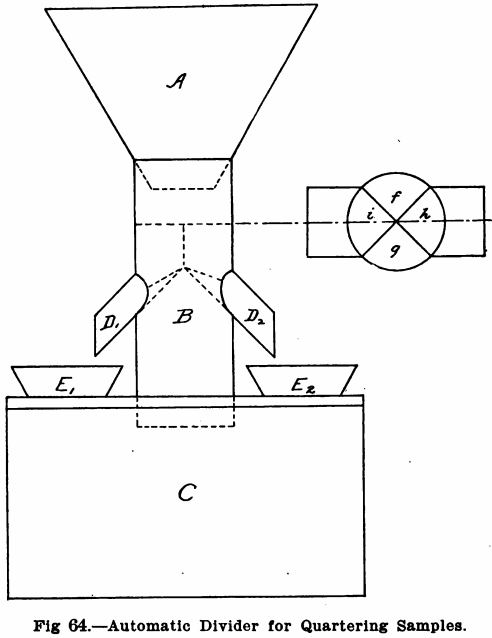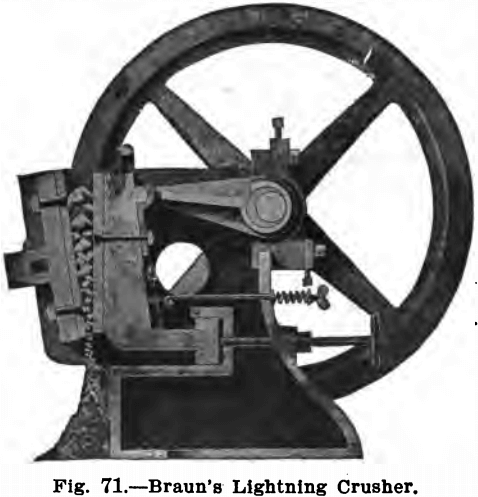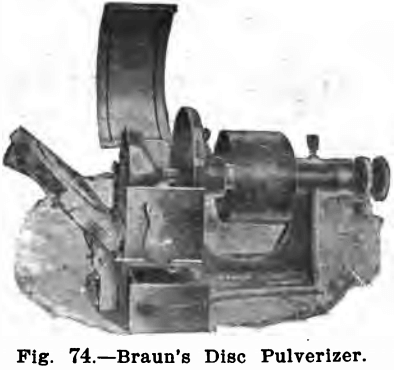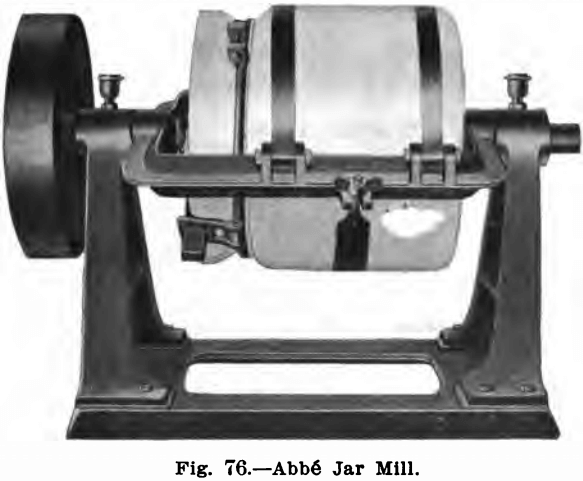Table of Contents
The apparatus used to reduce samples of ore, rock, coal, minerals, etc. from the dimensions usually encountered as they are brought to the laboratory, to the fine powder necessary for the analysis, may be divided into two classes, (1) crushers and (2) pulverizers. The former are used simply to prepare the material for the latter. Sometimes a pulverizer may be used also as a crusher. The ordinary iron mortar is an example of this, as it may be used not only to break down the large pieces of material to smaller sizes, but also to reduce these latter to a fine powder. Where small samples, of say from one to five pounds, alone are met with, the iron mortar will answer this purpose fairly well, particularly if much of this work does not have to be done, and in many small laboratories the small boy and the iron mortar will be found an excellent combination for preparing samples for analysis.
Reducing the Size of Bulk Samples
In preparing large samples for the laboratory, it is usual to crush the material by degrees, reducing the bulk of the sample after each crushing. For example, suppose a sample of twenty pounds of limestone is brought to the laboratory, consisting mostly of pieces of stone as large as a hen’s egg and under. The whole sample is first crushed to a size of about one-half inch particles, and this is then reduced to one-fourth its bulk by “quartering,” and the portion retained, about 5 pounds, is reduced to pieces the size of a pea and smaller. The sample of this size is again “quartered,” and the remaining sample, about 20 ozs., is crushed so that it will pass a 20 mesh sieve and from this coarsely ground powder about 1 or 2 ozs. is selected and powdered so fine that it will all pass a sieve of 100 meshes to the linear inch. For limestone, this would be fine enough, but for refractory ores and silicates, it would be necessary to select enough of this material (passing the No. 100 sieve) for the analysis, and pulverize so fine that no grit could be detected on rubbing over the back of the hand or biting between the teeth.
The size to which the sample should be crushed before reducing its bulk is usually determined by the nature of the material. When a sample of several pounds is received at the laboratory, if the material appears to be homogeneous to the eye, it will be sufficient to reduce it to a size passing a half inch screen. If the material is not of a homogeneous nature but is streaked with bands or shot with pebbles of various other materials the crushing should be much finer—unless the sample is a very large one, say 10 lbs. or more. Judgment is required in preparing samples, and the amount of work to be done can often be greatly abridged by a careful study of the material. The object in all cases is to have the small sample of one gram, or even less, weighed out on the balance pan, representative of the large one. Whether it is or not can usually be checked in a simple manner, by preparing two small samples from the original sample. That is when the first “quartering” is done, select two quarters and treat each as if it were a different sample. If the preparation of the sample has been properly done, analytical results upon the two will check. However, it is not usually with the laboratory part of the work of sampling that fault can be found, but rather with the field work. This can also be checked by taking two samples of the same pile or car of ore, coal, etc., or from the same deposit of limestone, clay, etc.
For determining the degree of crushing to be done, sieves are most convenient, the material being made to pass each sieve in turn. A convenient way is to make a sample of 5 lbs. or more all pass a one-half inch sieve. This sieve can be made of ordinary galvanized wire screening, having meshes ½ inch square, by tacking on to a wooden frame 18 inches square. The sieving may be done over paper or a sheet of light oil cloth. It can best be done, however, over a zinc or galvanized iron pan, 30 inches square and having a wall, 2 inches high, running around it, except for one corner, which is left open, in order that the pan may be conveniently emptied. The sample passing a ½ inch screen is then “quartered” and the quarter selected is made to all pass a screen having meshes ¼ inch square, or 16 to the square inch. This sample is now quartered or, if still very large and the material is homogeneous enough to admit of it, its bulk is reduced to about one pound and all of this is made to pass a sieve having 20 meshes to the linear inch. This sieve can be bought, and is what is known as a No. 20 sieve. The sample passing this sieve can then be reduced to one-quarter or even one-eighth its bulk and made to pass a sieve having 100 meshes to the linear inch (known as a No. 100 sieve). If further grinding is necessary, in order to allow the acids, etc., to act on the powdered material, the sample is spread out on a clean piece of paper or oil cloth, divided into a number of squares and as much of the material as will be needed for the analyses is taken by removing, from each square, a little of the material, on the point of a spatula. This material is then placed in an agate mortar and very finely pulverized.
The operation of reducing the bulk of a sample is usually known as “quartering” and is conducted in the following manner: The sample is poured upon a piece of clean, tough paper or oil cloth, or with large samples, on a clean floor, and mixed well. It is then heaped into a large pile and divided into four quarters by means of a thin sheet of metal, or, if the sample is small, a spatula is used. Two of these quarters (these diagonally opposite each other) are then scraped and brushed away and the two remaining ones are again mixed, divided into quarters and two of these rejected as before. The sample will now represent one-quarter its original bulk, and if the quartering is repeated again one-eighth its bulk, etc.
Mechanical appliances for quartering have also been devised. That shown in Fig. 64 is simple and easily constructed and works nicely. It consists of a cone or funnel, A, made of sheet metal, terminating in a short piece of galvanized iron or tin pipe, B. This opens into a wooden box, C. The top of the box, C, is loose so that the funnel and top may be removed and the box emptied when necessary. The pipe, B, is divided into four sections as shown in Fig. 64, two of which, f and g, empty into the box, C, while the other two, h and i, discharge into the pans, E1 and E2, by means of the pipes, D1 and D2. In using this sampler, the material to be quartered is poured into the funnel A, and dropping through the tube B is divided into four parts, two of which fall into the box and are rejected, while the other two go into the pans, E1 and E2. The cone, A, should be kept fairly full of material and stirred all the time, so that a solid stream of particles is passing through the pipe.
Laboratory Crushers
Various mechanical contrivances have been devised by different parties to lessen the labor of crushing and pulverizing with the ordinary hand mortar. One of these is to fasten a stout spring to one of the overhead rafters in the ceiling of the sampling room, and attach the pestle to the other end of this. It is claimed by those who use this device that the spring does not perceptibly add to the force required to strike a crushing blow, while it does greatly aid in lifting the pestle. Such a spring should be about 18 inches long, and have coils 1 1/8 inch in diameter made of the best steel spring wire, 1/8 inch in diameter. This arrangement is of course only intended for use with a very heavy pestle.
Where power is at hand, the pestle may be raised by means of cams and allowed to fall of its own weight. Such an arrangement does not seem to have any advantage over the crushers, either in cost or effectiveness, and is nothing like so convenient. For crushing large lumps of ore, the chilled iron plate and pestle shown in Fig. 65 will be found useful. Its inside dimensions are 24 x 24 x 3 inches, and the walls and sides are 3 inches thick.
The operator stands, in using this plate, and merely lifts the pestle and allows it to do the crushing by its own weight.
Where large quantities of ore have to be broken up, small crushers will be found much more convenient than the mortar and pestle, and every laboratory which handles samples as large as ten pounds and over should be provided with some sort of mechanical crusher. If possible, this should be power driven, but even if it has to be operated by hand, it will be found more convenient than the mortar and pestle.
Figure 67 shows Weatherhead’s Crusher, which is also a pulverizer. Its operation is evident from the cut.
Figure 68 shows a Bosworth Crusher, which may be operated either by hand or power. The Blake Crusher is somewhat similar to the Bosworth Crusher.
Gyratory Muller
Two excellent pulverizers, one of which can be operated by hand, are manufactured by Messrs. F. W. Braun & Co., Los Angeles, Cal. They are the gyratory muller and the disc pulverizer. The first of these is driven by hand and the second is intended to be power-driven from a small electric motor or the mill shafting.
The gyratory muller is shown in Fig. 73. In this muller the grinding is done by a ball or spherical pestle which revolves in a semi-spherical mortar with a particular twisting motion. This motion is imparted to the pestle by means of a right angle clutch extension. The material is rapidly crushed by the revolving ball, and the twisting motion prevents the material from being thrown ahead of the ball, by centrifugal force, and causes it to discharge through an opening, provided for that purpose, in the bottom of the mortar.
A coil spring around the ball shaft gives tight engagement between the surface of the ball and the mortar, and more or less compression may be obtained by means of washers above the spring. Loosening he thumbscrew allows the bale or arch to be swung back, and this lifts the ball from the mortar, giving access to the interior for cleaning. This machine has been found entirely satisfactory where large or small quantities of material are to be pulverized to a given size. The best results are obtained by screening the product each time, for if this is not done the finer particles surround the larger, preventing them from being pulverized. This appliance differs from the disc pulverizer described below, as it is necessary to feed and re-feed several times, according to the material, to obtain an extremely fine powder. This muller is priced at $35.00. Disc Pulverizers
Jar Mill
The Abbe Engineering Co., 220 Broadway, New York, manufacture a small jar mill which is shown in Fig. 76. This mill consists of a porcelain jar, 13 x 12½ inches, held securely in a cast iron frame by brass bands. Two of these bands are fastened at each end, but the third is held in place by a thumb- nut, which allows the jar to be taken from the frame. The frame is provided with a shaft at either end, and is revolved by a pulley as shown. The jar is closed by a porcelain cover, which is clamped tightly on the top of the former, a tight joint being secured by means of a rubber washer. The jar is half filled with porcelain balls. As the jar is concentric with the axle of the frame, the grinding is done by the pounding of the pebbles as the jar revolves. The speed of the latter is from 40 to 50 revolutions per minute, about 23 lbs. of porcelain balls are used for a charge and about 15 lbs. of material can be ground at a time. The mill is intended to be power driven, and may be run by a small motor.
These mills may be used for a great variety of laboratory work, and are very useful where large samples have to be very finely pulverized, as it is possible to grind extremely fine with them. Owing to the difficulty of cleaning the pebbles they are more used for experimental work than for preparing analytical samples. The pebbles may be separated from the ground material by using a large coarse mesh sieve, and they may be cleaned either by brushing with a stiff brush or by washing with water or acid, or by grinding and discarding a little of the material to be pulverized.
